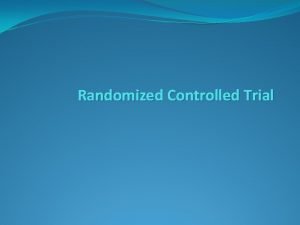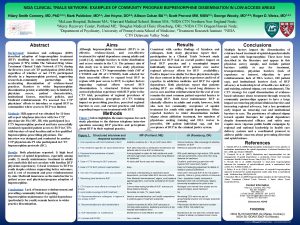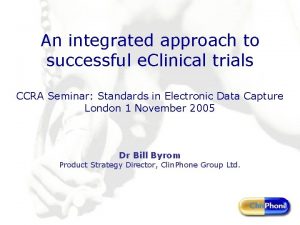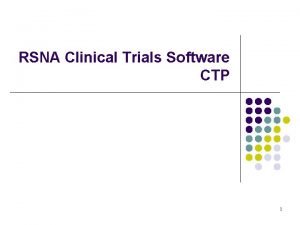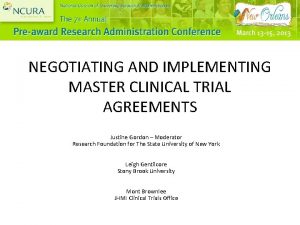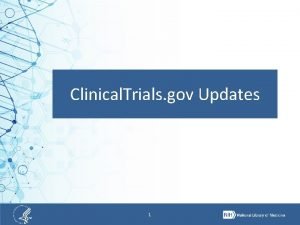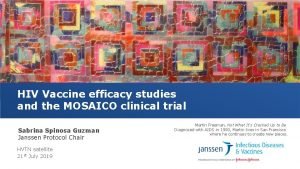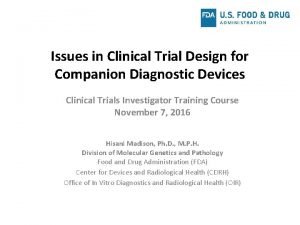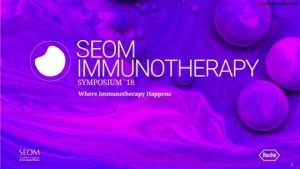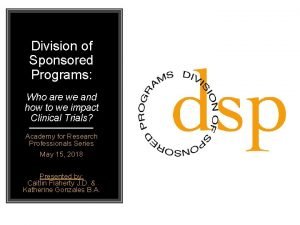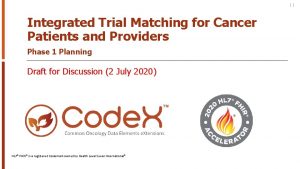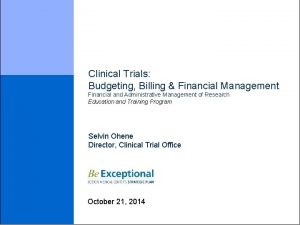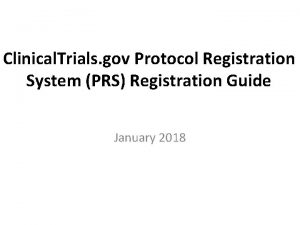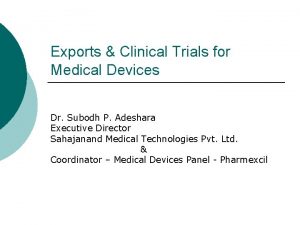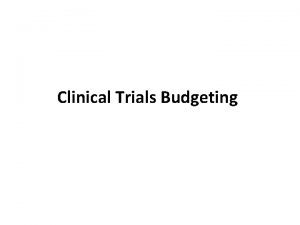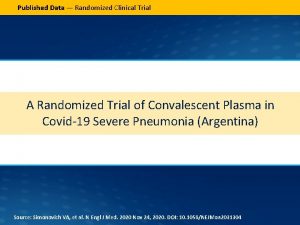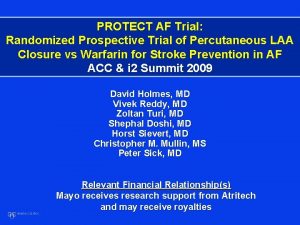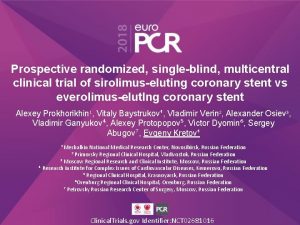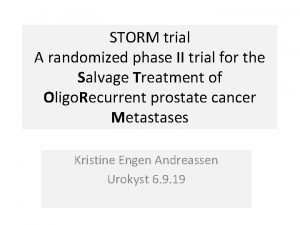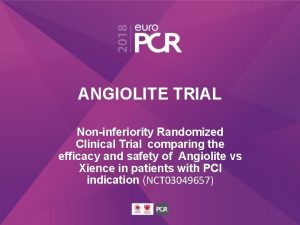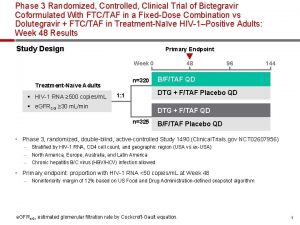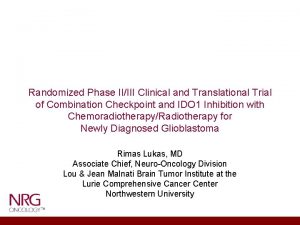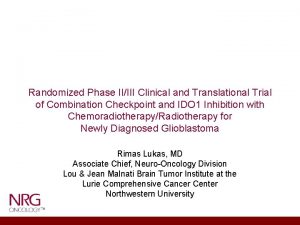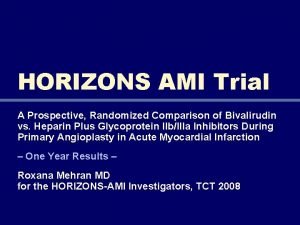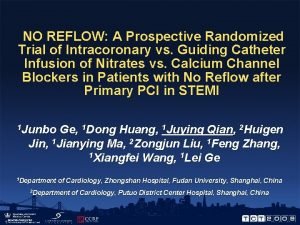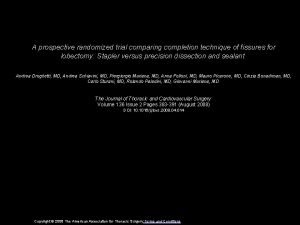A Phase II Prospective Randomized Clinical Trial of















- Slides: 15

A Phase II Prospective Randomized Clinical Trial of Time, Dose, Fractionation and Sequence of SRS and Immunotherapy in Melanoma Patients with Brain Metastases June 9, 2020

Study Team: Study Chair: Paul W. Sperduto, MD, MPP, Metro-Minnesota Community Oncology Research Consortium (MMCORC) Co-Chair, Radiation Oncology: Rupesh Kotecha, MD, Miami Cancer Inst. Co-Chair, Medical Oncology: Manmeet Ahluwalia, MD, Cleveland Clinic Co-Chair, Correlative Studies: Raju Raval, MD, Ph. D, Ohio State Univ. Co-Chair, Neuroradiology: Daniel Barboriak, MD, Ph. D, Duke University Co-Chair, Physics: Raj Varadhan, Ph. D, Minneapolis Radiation Oncology NRG Statistics: Mei Polley, Ph. D, University of Chicago NRG Brain Committee Chair: Minesh Mehta, MD, Miami Cancer Institute Champions for this trial from other NCTN research groups: SWOG: Zeynep Eroglu, MD & Peter Forsyth, MD, Moffitt Cancer Center Alliance: Paul D. Brown, MD, Mayo Clinic ECOG: Mohammad Khan, MD, Ph. D, Emory University

Template for Trials of Immunotherapy & SRS in Brain Metastases The proposed design of combined immunotherapy and radiation provides a template for future trials of patients with other primary tumors which commonly cause brain metastases and are treated with immunotherapy, including: Non-Small Cell Lung Cancer Triple-Negative Breast Cancer Renal Cell Carcinoma Melanoma

TITLE: A Phase II Prospective Randomized Trial of Time, Dose, Fractionation & Sequence of SRS & Immunotherapy in Melanoma Patients with Brain Metastases DESIGN: Two-by-Two Factorial Study Design SCHEMA: Melanoma brain metastases (0. 5 to ≤ 3 cm in max diameter) R R A A Arm 1 (1. 5 -2. 5 vs. 3. 0 -4. 0) N SRS: → IPI 3 mg/kg + NIVO 1 mg/kg q 3 wk x 4 NIVO 3 mg/kg q 2 wk N SRS in 1 fraction to all lesions D Arm 2 O HF-SRS in 3 fractions to all lesions M I Prior BRAFi/MEKi (yes/no) Resection allowed of up to 4 lesions if clinically indicated Absence of leptomeningeal disease T I F Y Arms 1 and 2 D O A R 1 -20 lesions Melanoma-mol. GPA: S T M I Z E Steroid Dose at randomization (1: 1) (IPI/NIVO within 2 wks of SRS) Arms 3 and 4 IPI 3 mg/kg + NIVO 1 mg/kg q 3 wk x 4 NIVO 3 mg/kg q 2 wk→ RT (SRS after 1 st dose of ICI) Z E Arm 3 SRS in 1 fraction to all lesions (1: 1) Arm 4 (Dex 0 -2 vs > 2 -8 mg qd) HF-SRS in 3 fractions to all lesions

HYPOTHESES 1. Three fraction SRS is more immunogenic than single fraction SRS 2. SRS prior to immunotherapy results in better outcomes than the reverse sequence RATIONALE: 1. The most immunogenic SRS technique is unknown. Vanpouille-Box (Nature Commun 2017, Ngwa/Formenti, (Nat Rev Cancer 2018), Chen (IJROBP 2018) and Theelen (JAMA Onc 2019 suggest 3 fraction SRS is more immunogenic than single fraction SRS. 2. The optimal sequence of SRS and immunotherapy is unknown. Pommeranz (IJROBP 2020) suggests SRS prior to immunotherapy is better. 3. Two recent trials [Amaral (J Immunother Cancer 2020) and Pomeranz (IJROBP 2020)] show a survival advantage for local therapy (SRS) with ipilimumab + nivolumab compared to ipi + nivo alone. 4. N 0574, Brown et al (JAMA 2016) confirmed IC-PFS 6 with SRS alone of 82%. 5. Two phase II trials [Checkmate 204, Tawbi NEJM 2018) and Australian ABC (Long, Lancet 2018)] have shown in asymptomatic patients that ipi + nivo results in IC-PFS 6 of 53 -64%

BACKGROUND: 3 FRACTION SRS MAY BE MORE IMMUNOGENIC THAN SINGLE FRACTION SRS Vanpouille-Box et al showed a marked increase in the CD 8 tumor infiltrating dendritic cells (TIDC) after 8 Gy x 3 fractions but not in single fractions of 20 Gy. Vanpouille-Box, Nature Communications 2017; 8: 15618

BACKGROUND: SRS BEFORE IMMUNOTHERAPY MAY RESULT IN BETTER OUTCOMES THAN IMMUNOTHERAPY BEFORE SRS German Dermatological Cooperative. Oncology Group (De. COG) Multi-institutional (23) retrospective study N = 380 Treatment Median Survival Ipi + Nivo 16 mo Ipi + Nivo + LT 24 mo p = 0. 009 LT: local treatment (either surg or SRS) Amaral et al, J Immunother Cancer 2020

BACKGROUND: Comparison of the Literature Publication Author/Year Dx Australian ABC Long et al. 2018 Melanoma Ipi+Nivo Rx Nivo Sx N 6 mo Median IC-PFS EC-PFS OS no 35 53% 51% NR no 25 20% 35% 18. 5 64% 76% NR Checkmate-204 Tawbi et al. 2018 Melanoma Ipi+Nivo no 94 N 0574 Brown et al. 2016 All Primaries SRS yes 111 82% 10. 4 p=0. 92 WBRT+ SRS yes 102 93% 7. 4 De. COG Melanoma Ipi+Nivo Amaral et al. 2020 Ipi+Nivo+LT yes 160 16 p=0. 009 yes 220 24 Dx: diagnosis; Rx: treatment; Sx: symptomatic; N: number; mo: months; IC: intracranial; EC: extracranial; PFS: progression free survival Ipi: ipilimumab; Nivo: nivolumab; SRS: stereotactic radiosurgery; WBRT; whole brain radiation therapy; LT: local treatment (either resection or SRS); NR: not reached

Factors Favoring Successful Accrual We are confident we can complete accrual for this study because: 1. Melanoma brain metastases are common; 30, 000 -50, 000/year. 2. The sample size (n=132) is relatively small. 3. Eligibility of the NRG study has some but not complete overlap with the SWOG S 2000 study. For example the SWOG S 2000 trial is limited to BRAF-positive patients only. 4. Three other NCTN groups (SWOG, Alliance and ECOG) have agreed to provide written statements of support and assigned “champions” within each of those groups to encourage accrual to the NRG study from those groups. SWOG champion for the NRG trial: Zeynep Eroglu, MD, Moffitt Alliance champion for the NRG trial: Paul Brown, MD, Mayo Clinic ECOG champion for the NRG trial: Mohammad Khan, MD, Ph. D

ELIGIBILITY 1. Biopsy proven melanoma 2. < 20 new untreated brain metastases confirmed by brain MRI 3. Lesions 0. 5 – 3. 0 cm in largest dimension 4. Patients may have received prior BRAF or MEK inhibitors 5. Performance Status: ECOG 0 -2 are eligible 6. Patients with Melanoma-mol. GPA > 1. 0 are eligible 7. Patients receiving steroids < 8 mg qd dexamethasone are eligible.

ENDPOINTS Primary Endpoint: Intracranial Progression-Free Survival at 6 months (ICPFS 6), defined as percentage of patients who are alive and free of intracranial progression at the 6 -months disease evaluation Secondary Endpoints: • Local Control at 6 and 12 months • Distant Intracranial Control at 6 and 12 months • Progression-free survival (PFS), defined as time from randomization until intracranial progression, extracranial progression, or death due to any cause, whichever occurs first • Overall survival (OS), defined as time from randomization until death due to any cause • Biomarker: Antigen Release (which schedule is most immunogenic) • Adverse Radiation Event (evaluate safety of fractionation and sequencing of treatment) • Planned subgroup analysis of patients who received both treatments within 1 week vs. 2 weeks • Planned subgroup analysis of symptomatic (KPS = 100) vs. asymptomatic pts (KPS < 100)

CORRELATIVE STUDIES Molecular profile: BRAF, MEK and PDL 1 status Peripheral Blood: q 3 -6 mo x 1 year for T Cell Receptor (TCR) sequencing for a) peripheral blood lymphocytes; b) myeloid derived suppressor cell quantification by flow cytometry; c) T cell phenotype analysis by flow cytometry Tumor Tissue: (one time evaluation for primary tumor & brain met tissue if available, for a) Immunohistochemical (IHC) analysis for T cell infiltration b) IHC analysis for PDL-1 c) Tumor immunophenotyping d) Tumor mutational burden assessment

STATISTICAL DESIGN (control) (experimental) (control) SRS → IPI + NIVO→SRS (1 fx) Arm 1 Arm 3 FSRS (3 fx) Arm 2 Question 1 Arm 4 Question 2 Two primary study questions: • Question 1: Fractionated SRS is more immunogenic than single fraction SRS. • Question 2: SRS followed by immunotherapy is associated with superior outcomes than the reverse paradigm.

STATISTICAL DESIGN • No plausible evidence that the effect of SRS fractionation would be different depending on the sequence of SRS and IPI+NIVO (i. e. no interaction between the SRS fractionation and sequence) 2 by 2 factorial design • Assume: • same primary endpoint for both study questions (IC-PFS 6) • “control” vs. “experimental” arm IC-PFS 6: 65% vs. 82. 5% • 1: 1 randomization • 1 -sided 0. 10 level binomial test • Design: • A total of 120 eligible patients needed to yield ~82% power • Accounting for 10% loss to follow-up, the trial will enroll about 132 patients. • Assuming accrual of 4 pts per month and minimal accrual in the first 6 months, the trial will take about 3. 75 years to complete.

STATISTICAL DESIGN • Futility Interim: • One futility interim will occur when 60 eligible patients have been enrolled (i. e. 50% information) – projected to occur at about 27 months after study initiation. • If the IC-PFS 6 estimate favors the control arm in either comparison, subsequent randomization to its corresponding experimental arm will cease (all subsequent patients will receive that control regimen). • If futility is indicated for both questions, the study will be terminated early. • Analysis plan (for primary endpoint): • ITT analysis based on 1 -sided 0. 10 level exact binomial test • If loss to follow-up (LTFU) or early withdrawal in any patient prior to reaching the 6 -months landmark, IC-PFS 6 comparison will be based on Kaplan-Meier estimates and Greenwood’s formula to estimate the variances.
 Advantage of randomized controlled trial
Advantage of randomized controlled trial Accelerated clinical trial agreement acta
Accelerated clinical trial agreement acta Nida clinical trials network
Nida clinical trials network Clinical trial iwr
Clinical trial iwr Ctp dicom
Ctp dicom Master clinical trial agreement
Master clinical trial agreement Clinicaltrials gov api
Clinicaltrials gov api Mosaico clinical trial
Mosaico clinical trial Ivd clinical trial design
Ivd clinical trial design Morpheus bms
Morpheus bms Uiris uiowa
Uiris uiowa Clinical trial matching service
Clinical trial matching service Clinical trial financial management
Clinical trial financial management Prs clinical trials
Prs clinical trials Clinical trial exports
Clinical trial exports Clinical trial budget example
Clinical trial budget example
